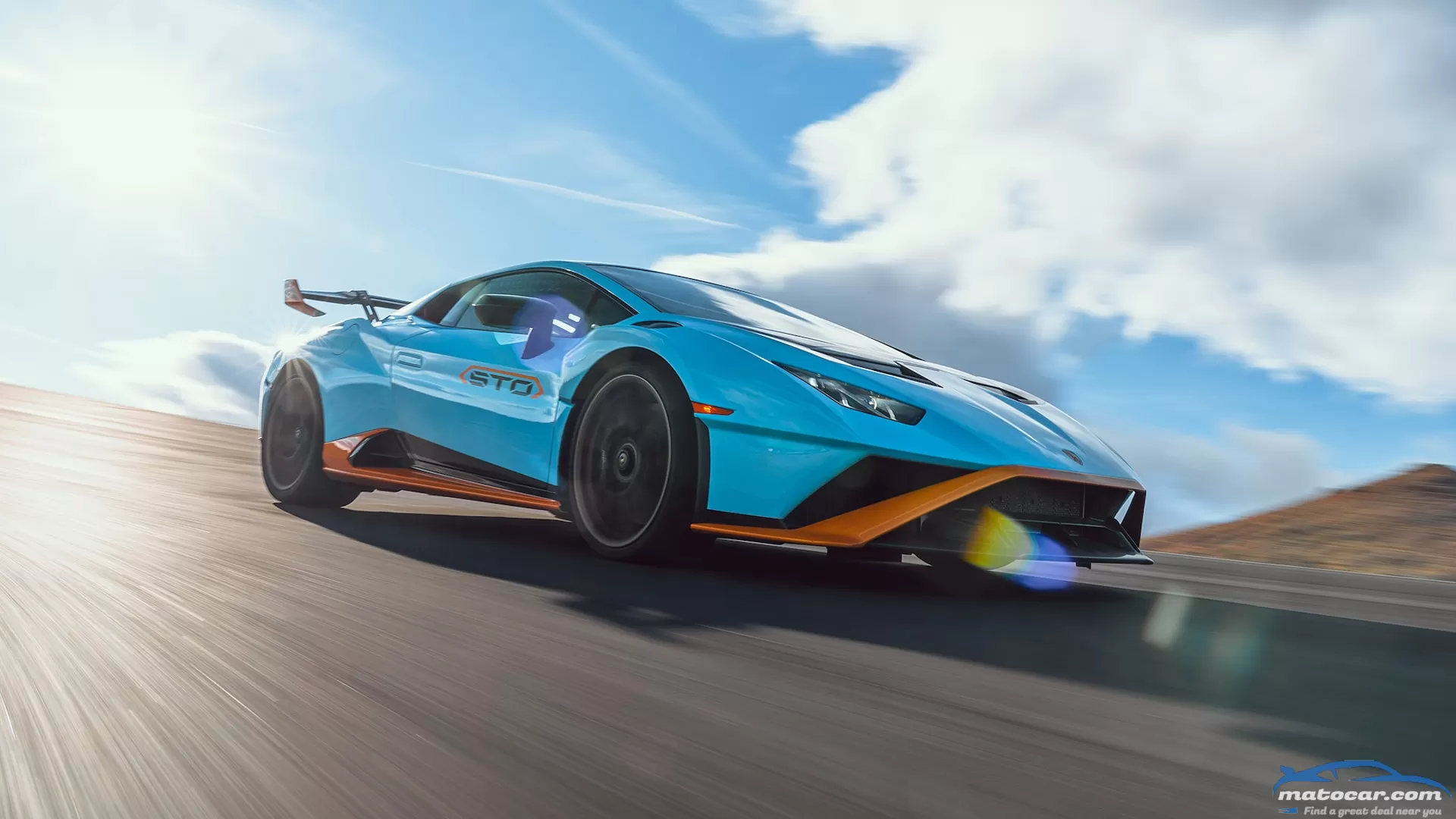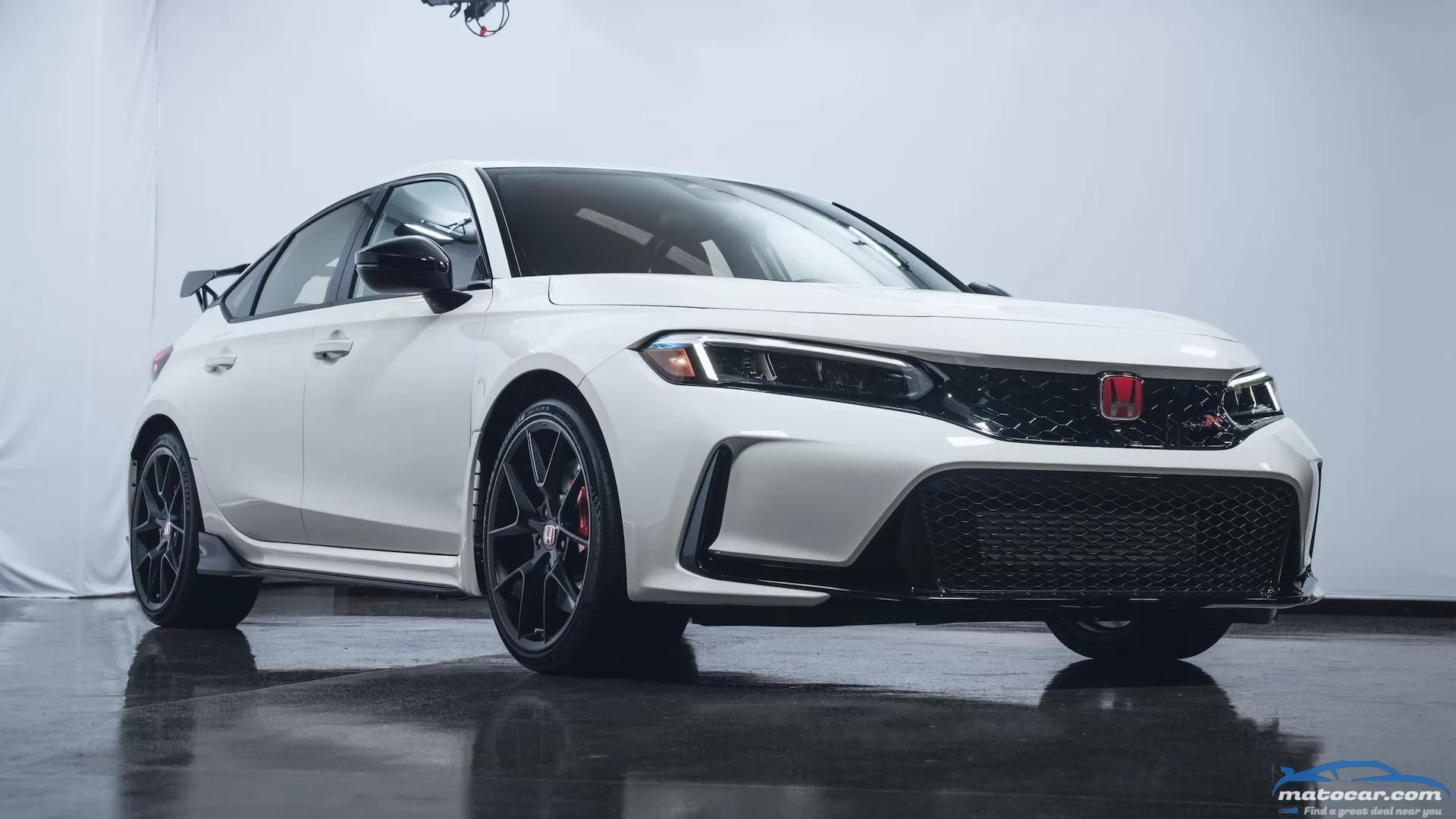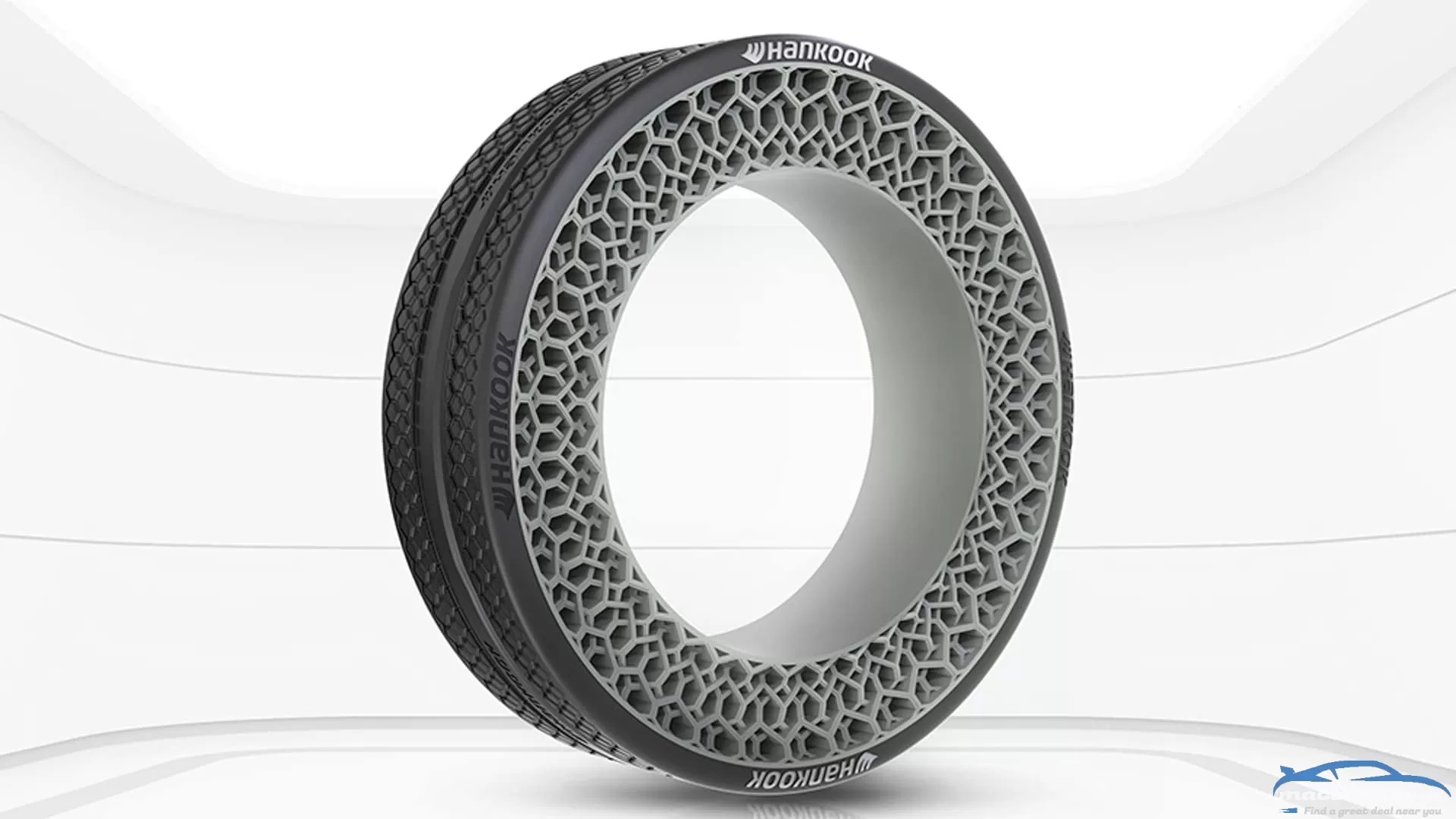Lamborghini Huracán STO PVOTY Review: STO-M-G This Thing Is Insane

Pros
- Near limitless grip
- Quicker-than-you-can-think responses
- Biblical brakes
Cons
- Confusing drive modes
- No performance auto-shifting mode
- Needs a bigger shift light
It's not often a car comes along where the only thing you can find to complain about are the names, functions, and number of drive modes, but here we are. The 2021 Lamborghini Huracán STO is so insanely good to drive, we're left with the nittiest nits to pick.
"You look at the STO and its wings 'n' things," deputy editor Alex Stoklosa said, "then consider that it's shoving a V-10's worth of power to only the rear wheels, and you assume it'll be hairier than a barbershop floor. Not at all. There is so much grip front and rear, and the chassis is so balanced, that it drives nothing like it looks. There is no evil here. Sure, the Lambo hustles in ways most cars don't or can't, but it simply has no vices while furiously raging."
You could call it a complaint for lack of others, but the amount of time some judges felt they needed to fully understand the car's limits was a bit longer than usual, simply because the limits are so high you need a telescope to see them. Once you truly understand what it's capable of, though, you never want to stop driving it. On the street, on the track, it doesn't matter.
Credit the brilliant blending of adaptive magnetorheological shock absorbers, rear steering, racing brakes, and Bridgestone Potenza Race tires for the STO's direct connection to your brain's pleasure center. The front end changes direction quicker than you can think it while the rear stays behind you no matter the speed unless you very deliberately kick it out. When you do, the car breaks away beautifully, allowing you to ride that slip into the perfect amount of rotation.
Mostly, though, it just goes. The damn near race-spec V-10 delivers a perfect progressive powerband that never wallops the rear tires with more torque than they can handle (which is, admittedly, a lot), so you can stand on the throttle leaving every corner, and the STO will grab and go. Get to the next turn, and the brakes require only gentle but deliberate pressure to stop the car like you just grabbed the No. 3 wire on an aircraft carrier's deck.
Not just a one-lap pony, the Huracán STO will do it over and over, every corner, every lap, all day long. It's so rewarding and fulfilling to drive, you never want to stop. You can't automatically say these things about every mid-engine supercar with 600-plus hp.
About those nits. Some judges found the drive modes confusing, assuming the STO mode would be the most aggressive since it shares the car's name. ("STO" stands for Super Trofeo Omologato, meaning this is the road version of the Huracán Super Trofeo track-only race car.) But STO is actually the "around town" mode, and many felt it was way too docile. Corsa is the mode you want to be in, but keep in mind it's the full race mode with manual-only shifting and reduced stability control. Several judges found themselves wishing for an intermediate mode with lighter steering than Corsa and far more aggressive automatic shifting. But alas, the only other mode is Pioggia, the wet weather mode.
Since we're whining, an actual shift light instead of the graphics in the digital instrument cluster would be nice. The engine just revs forever, right until it suddenly doesn't, so you need the upshift indication in Corsa.
But again, all you really need to know about how ridiculously awesome this car is to drive is that we can't find anything better to complain about. The Huracán STO is an apex predator at its apex, fully bestowing the thrill of the hunt to anyone who slips behind the wheel.
2021 Lamborghini Huracán STO Specifications Base Price/As tested $333,633/$442,033 Power (SAE net) 630 hp @ 8,000 rpm Torque (SAE net) 417 lb-ft @ 6,500 rpm Accel, 0-60 mph 2.8 sec Quarter-mile 10.7 sec @ 132.3 mph Braking, 60-0 mph 95 ft Lateral Acceleration 1.16 g (avg) MT Figure Eight 22.3 sec @ 0.99 g (avg) EPA City/Hwy/Comb 13/18/15 mpg Vehicle Layout Mid-engine, RWD, 2-pass, 2-door coupe Engine, Transmission 5.2L port- and direct-injected DOHC 40-valve 90-degree V-10, 7-speed twin-clutch auto Curb Weight (F/R DIST) 3,390 lb (42/58%) Wheelbase 103.1 in Length x Width x Height 179.0 x 76.6 x 48.0 in On Sale Now Show AllYou may also like
After months of teasers, the wait is finally over. The 2023 Honda Civic Type R has been revealed, and unlike previous years, the performance-oriented model launched on American soil with IndyCar driver Colton Herta behind the wheel. For a long time, Americans were banned from purchasing the Civic Type R, but this time Honda is making a statement by doing the global reveal in Los Angeles.The Type R joins the Si and Sport models in the Civic's lineup and stands as the pinnacle of performance in Honda's portfolio. The 2023 model will be the most powerful Honda car in America, with Honda promising more power than ever before.Untamed PerformanceWhile Honda is still tightlipped about its horsepower and torque numbers, we're told it will have more power than before. That means we'll see figures north of 306 hp and 295 lb-ft of torque—the numbers for the current Type R. The familiar 2.0-liter four-cylinder turbo returns, except this time it will be mated to an improved six-speed manual transmission with rev-matching. As of this time, Honda is not planning to offer an automatic transmission in the Type R.Honda says the new Type R will be rewarding and addictive to drive. With an enhanced suspension system and steering performance, we're told the driving feel is direct and engaging, though we'll have to wait until this fall to try it ourselves. But with more power, a new, lightweight chassis, more body rigidity and improved high-speed stability, it sounds like the Type R has everything to deliver a thrilling experience behind the wheel.Just as important, Honda made sure the Type R would stop confidently. The 19-inch wheels are wrapped around Michelin Pilot Sport tires, which should provide sharp grip on the corners and under hard acceleration and stopping. While Honda didn't reveal any specs, the big, red Brembo calipers up front will make sure the Type R brakes properly.With its compact, hatchback body, loads of power and handling hardware, the Type R stands out in the segment. This time, however, it will have more competition. Newcomers such as the Toyota GR Corolla and Hyundai Elantra N have gotten the enthusiast's attention, and the Volkswagen Golf R is back for a new generation. While the GR Corolla and Golf R get all-wheel drive traction, the Civic Type R and Elantra N are front-drive only. But the Honda will continue to stand out with its power numbers. The Elantra N makes 276 hp and the GR Corolla pumps 300 hp, and we expect the updated Type R's numbers to be between 307 and 315 hp. That means the Golf R—with its 328 hp—should continue to be the most powerful of the group.Even if the power numbers don't increase by a lot, there will be a lot to like about the new car. The current-generation Type R continues to be among our favorite hot hatches in the market.Mature ExteriorDespite the 11th-generation Civic gaining a more mature styling, the Civic Type R does a good job distinguishing itself from the rest of the lineup. While the entire Civic lineup lost its race boy design, the new model will be more appealing to those who thought the previous design was too wild. The new Type R is longer, wider, and lower than the outgoing model, and every aerodynamic element is there for a reason.From the front, the honeycomb grille in the lower fascia gives the Type R a distinctive look, and sporty elements on the fascia stand out. Other dynamic cues include air vents on the hood and behind the front wheels. If that's not enough to differentiate it from the rest, the red Honda logo and Type R badge on the grille pop out.From the profile, the side skirts help redirect the wind for better aerodynamics. Unlike any other Civic, the second half of the rear doors expand outward to give the Type R more hips. The rear continues to be the best angle, with a massive wing that's hard to miss and a redesigned rear diffuser that houses the signature three-round exhaust system.There will be five different colors available—Rallye Red, Racing Blue Pearl, Crystal Black Pearl, Sonic Grey Pearl, and Historic Championship White. The latter is exclusive for Type R and one that's famous among Honda enthusiasts.A Familiar InteriorThe red bucket seats and red carpet—two signature elements for the Type R—are back. Comfortable and supportive, the suede-like seats should be able to keep the driver and front passenger tight when the driving experience gets intensive. A numbered Type R badge is now placed on the passenger's dash.A new +R driving mode will show exclusive graphics with engine rpms, indicator lights and gear position indicator displayed at the top, while the bottom display will have other information selected by the driver. A stopwatch to record lap times and the ability to share driving videos is also incorporated in the infotainment system.The rest of the cabin will be familiar to Civic drivers. A honeycomb mesh grille expands across the dashboard and houses the air vents. The HVAC controls are backlit for a premium look, and the digital instrument cluster is standard. Like the top-trim Civic Hatchback, the Type R comes with a 9.0-inch touchscreen with wireless Apple CarPlay and Android Auto, as well as three USB ports.Is the 2023 Honda Civic Type R Worth It?We'll have to wait a little longer to find out the Type R's performance figures, but from what we've seen so far it looks like Honda's promise of delivering a thrilling driving experience might be fulfilled. The 2023 Honda Civic Type R will be on sale this fall, and we can't wait to get behind the wheel. Although Honda didn't mention pricing, we don't expect it to increase too much from the current generation, which starts at $38,910.
Looking to deck out your Tesla with carbon-fiber dress-up bits? A new lineup of carbon parts from Unplugged Performance bring more than an extra dash of splash—they're manufactured by none other than Koenigsegg. Yes, that Koenigsegg, the hypercar manufacturer behind crazed top-speed runs and exotic (internal-combustion) engine technologies.This collaboration, dubbed UP x KAM, in reference to Koenigsegg Advanced Manufacturing, kicks off with carbon-fiber spoilers for the Tesla Model 3, Model Y, Model S, and Model X, as well as wider front fenders and a "high-downforce" spoiler for the Model 3 specifically. More parts are promised later this year.While the parts themselves cost significantly less than, say, one entire Koenigsegg hypercar, these aren't Pep Boys bits. The regular spoilers for the Model 3 and Y run $1,745 apiece and are claimed to aid each vehicle's aero efficiency. The "long-tail" spoilers for the Model S sedan and X SUV cost a cool $2,495. And those wider Ascension R front fenders for the Model 3? Those are listed at an eye-popping $8,845; to be fair, the lightweight wings lend the Model 3 a spicy vibe while their 0.8-inch extra width helps accommodate up to 315-section tires, compared to the biggest a regular 3 can comfortably swallow, 275 to 295s. Unplugged Performance also claims the fenders, when used in collaboration with other Ascension-R front-end parts, help with downforce.Every component comes with a nifty UP x KAM sticker denoting the Koenigsegg, er, koennection, and each piece is handmade. Quantities of these first-run products are limited, so if you want some for your Tesla, you better hurry. Unplugged Performance also has its own assortment of exterior upgrades for Teslas, in case you miss out.
Ever since Michelin revealed the Tweel airless tire in 2004, it has been on the radar for anyone looking to reduce the need for monitoring tire pressures for optimum fuel efficiency and tire safety—at least for applications like ride-on lawnmowers and ATVs. Looks like Hankook is the next to get in on the act with its i-Flex concept that debuted on the Hyundai Plug-n-Drive module concept at CES 2022.What Makes The i-Flex Different?Compared to Michelin X Tweel, the Hankook i-Flex is far more organic in its design—and that's by design. The tire's structure was inspired by "the cellular structure of living organisms." According to Hankook, this allows for "better shock absorption while allowing hexagonal and tetragonal cell structures of different rigidity join together for more stable load support."Made For An Autonomous TableFor now, the tire design is just a concept limited to a 10-inch outer diameter, which was perfect for the Hyundai Plug-n-Drive (PnD) module that also debuted at CES. You can almost think of it as a rolling, self-driven table. "The PnD modular platform is an all-in-one mobility solution that combines intelligent steering, braking, in-wheel electric drive and suspension hardware. The single wheel unit uses a steering actuator for infinite wheel rotation." In other words, it can turn around itself like that Lazy Susan on your table—except it's the whole table and it can drive around. With LiDAR and camera sensors, a PnD-enabled object can move autonomously, and the PnD modules can be attached to virtually anything that needs additional mobility.When's It Coming?The i-Flex has been in the works from Hankook since 2010, but a production version still isn't in sight. There are no explicit plans for building something larger than these small concept tires, but we have to imagine that Hankook is considering scaling up the concept for cars. We just don't know how far in the future that'll be.


-is-making-parts-for-teslas.webp)

0 Comments